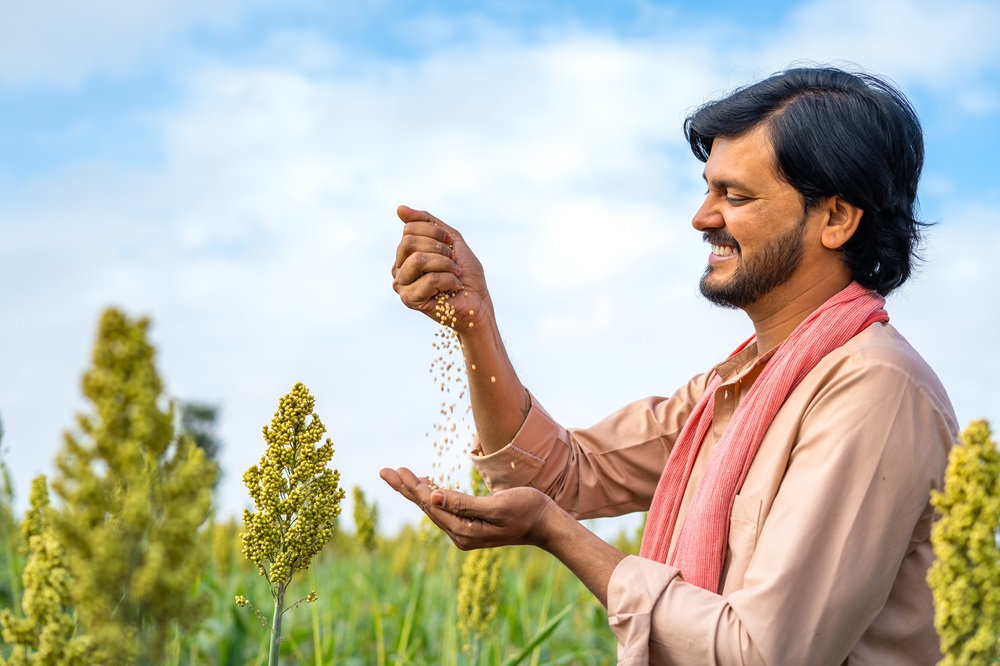Analysis of FY24 Agricultural Budget: Advancements and Shortcomings

The Indian economy recorded an impressive overall GDP growth rate of 8.2%, with projections indicating it will stay above 7% in FY25. However, the agriculture sector’s growth rate declined sharply from 4.7% in FY23 to 1.4% in FY24, primarily due to reduced foodgrain production caused by delayed and poor monsoons linked to El Nino. This decline in agricultural growth is particularly concerning as rural consumption, which is set to outpace urban demand by the end of this fiscal year, relies heavily on agricultural income. Consequently, the budget allocation for the agriculture sector was eagerly awaited, as steady agricultural growth and employment in the sector are crucial for maintaining this rising demand in the future. The following paragraphs lay out the budget allocation to different departments and schemes for the FY 2024-25.
Department-wise allocation
- In FY24, the agriculture sector received a budget allocation of approximately INR 1.52 lakh crores, consistent with previous years.
- The agriculture ministry’s share of the overall budget was 2.74%, nearly the same as in 2023-24, but slightly down from 3.36% in 2022-23.
- Of the total allocation:
- INR 1,22,528.77 crores were earmarked for the Department of Agriculture and Farmers Welfare.
- INR 9,941.09 crores for the Department of Agricultural Research and Education.
- The allied sectors of fisheries and animal husbandry saw significant budget increases, with a combined allocation of INR 7,137.68 crores, up 27% compared to the 2023-24 revised estimates.
- The Department of Animal Husbandry and Dairying received INR 4,521.24 crores, a 15% increase.
- The Department of Fisheries was allocated INR 2,616.44 crores, marking a substantial 53.8% rise.
Scheme-wise allocations include:
- Pradhan Mantri Annadata Aay Sanrakshan Yojna (PM-AASHA) received an outlay of INR 6,437.50 crores, an increase of INR 4,237.50 crores compared to 2023-24, aiming to boost the production of oilseeds and edible oils.
- The ‘Formation and Promotion of 10,000 Farmer Producer Organizations (FPOs)’ scheme saw its allocation rise to INR 581.67 crores, up from INR 450 crores.
- There has been a renewed focus on digital crop surveys, with plans to implement a digital crop survey for the Kharif season using the Digital Public Infrastructure for Agriculture (DPI) in 400 districts. This will aid in the precise estimation of crop yields and production.
- To improve the vegetable supply chain, the budget proposed creating large-scale production clusters near key consumption hubs.
What does the above allocation mean, and is it enough for agricultural growth?
India’s agriculture sector is on the brink of a multi-faceted transformation driven by technological advancements. The Budget 2024 demonstrates a strong commitment to enhancing agricultural infrastructure, boosting digital capabilities, and supporting both traditional and emerging agricultural sectors. Emphasizing better yields and sustainable farming practices can mitigate climate change challenges, but this requires increased investment in research and development (R&D). Despite the evident impact of climate change, the Department of Agricultural Research and Education has seen an increase of 0/7% in allocation. This lack of R&D in the sector can have a negative impact on food security and agricultural growth, as witnessed in this year’s growth rate.
There is also some room for improvement in specific allocation towards schemes related to market linkages and extension services. It inadequately addresses the issue of farmers’ indebtedness as the allocation for the interest subvention scheme for agricultural credit has been reduced. In recent years, farmers have seen increasing post-harvest losses, but the budget relies on the same credit guarantee scheme for building agricultural infrastructure without specifying new investments. The food processing industry, growing at a steady but sluggish 5.35% average annual growth rate, could not receive new allocations. The focus is to shift agricultural practices towards sustainability and organic, and investment in clean-energy sources in agriculture is integral. The schemes working on adopting clean energy in agriculture need to be made more robust, which is where more allocated resources for adoption and incentives for using clean energy sources in agriculture could have helped.
Conclusion
The budget attempts to incorporate emerging technologies and emphasizes welfare through free ration and direct benefit transfer schemes, but it needs to address key areas for increasing farmers’ income. A more explicit plan for value addition in agriculture, enhancing farmers’ incomes, and creating opportunities for food processing and exports is needed. Transforming agriculture into a growth engine requires farming practices that benefit both farmers and the environment. Effective policymaking, including re-orienting subsidies and programs, can increase productivity and environmental sustainability. Enhancing private sector investment in agriculture is vital to provide impetus to the agriculture sector. Investment in technology, production methods, marketing infrastructure, and reduction in post-harvest losses need to be scaled up. A greater focus on post-harvest infrastructure and the development of the food processing sector can reduce wastage and increase the length of storage, ensuring better prices for the farmers. Smallholder farmers’ incomes cannot be increased by producing rice, wheat, or even millets, pulses, and oilseeds. They need to move to high-value agriculture – fruits and vegetables, fisheries, poultry, dairy, and buffalo meat. Once the incomes of smallholder farmers increase, the demand and consumption will multiply in rural areas.
The FY24 budget marks a significant move towards utilizing digital infrastructure for accurate crop surveys, enhancing production through initiatives like PM-AASHA, and providing greater support to allied sectors such as fisheries and animal husbandry. It will be intriguing to see how the sector evolves in the coming years, balancing technological incentives with addressing unemployment and increasing farmer incomes, all while sustaining sectoral growth and rural demand.
Shubham Pathak – Research Manager, Sambodhi


